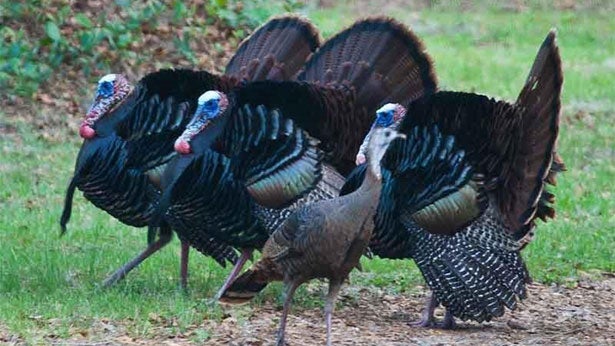Spring Forward for Turkeys
OutdoorChannel.com 03.14.14

By: Posted 03-12-2014 OutdoorChannel.com in Opening Days by Steve Rogers
Permitted use provided by: OutdoorChannel.com.
When it comes to predicting the availability of birds for a particular spring turkey season, it helps to have a good memory.
Because of how the weather conditions were two and three springs earlier typically dictates the prime gobbler population for this season.
There are several factors that figure into the equation, but weather is a chief component – so much so that altering conditions not only can affect production differently from region to region, but even county to county.
“It definitely depends on the areas that you’re in,” said Jeremy Flinn, the Midwest regional wildlife biologist for Cabela’s. “A lot of what happens for our spring turkey season depends on the past hatch success rate. The things that we look at in terms of the hatch success, predators obviously play a big role in that, but an even bigger role is usually the weather.”
“Whenever you look at the prospects for any given spring turkey season, in general you look at the hatch 2-3 years ago,” said Jason Isabelle, a turkey biologist who works a resource scientist for the Missouri Department of Conservation. “The bulk of the birds folks are going to be shooting are 2- and 3-year-old birds. In this case, 2011 and 2012 both being good production years, we should have pretty good conditions this spring. I would expect them to be what most folks encountered last year.”
That said, the numbers can vary fairly dramatically in different areas, depending on the amount of rainfall during the spring two and three years ago, again when this season’s top strutters were only hatchlings. For the most part, it all stems from what the experts call the “wet hen hypothesis.” “Basically, the idea being when that hen is incubating, if she’s wet, she’s going to be giving off more odor than she would if she was dry,” Isabelle said. “As a result, nest predators would have an easier time locating her and her nest.
“It’s just like if you were out pheasant hunting or quail hunting, if the conditions are moist, the bird dog is going to have an easier time locating those birds than they would if it was low humidity and dry.”
Several states, Arkansas and Georgia included, have seen their adult turkey population affected negatively in recent years by a succession of cool, overly wet springs.
“Another way that research has shown that could potentially impact production,” Isabelle said, “when the polts hatch out if the egg, they can’t regulate their body heat very well. They depend on the hen to do that. If you get a cold, wet, driving rain when they are relatively young, they can get hypothermia and die that way, too, from exposure. So there’s a couple different ways the weather can impact production.”
Very late freezes can also negatively affect polt production, but adults typically handle harsh conditions rather well.
“When you start talking about places like Minnesota and further north, they can have a pretty substantial winter kill on turkeys,” Isabelle said. “They’re pretty hearty birds in general, but the winters they have up there can be limiting and in large part dictate how far north the birds do go.
“In most parts of the country, it would have to be a real, real tough winter in a year where there was an acorn bust, for example. It would take something like in order to really impact adult survival. But generally they make it through the winters just fine.”
Turkey typically start the spring eating acorns from the previous fall, and they switch to grasses, sedges and broadleaf plants as the green-up takes place. The proteins gained from eating insects are particularly important to the hens entering nesting season.
“In the wintertime, the turkey are able to forage,” Flinn said. “A lot of times you go through the woods during the wintertime and you see major turkey scratchings in the oak flats, where they were looking for some of those remnant acorns. If you can find any standing bean or a field that maybe has been corn that’s been picked and has got waste corn or grain, you’ll definitely see all kinds of birds out there.
“They manage to make it through and survive. There are some that will fall victim to (the harsh winter). But it all really comes back to that springtime period that’s going to affect them more than what’s happening right now.” Also, the drought conditions that continue to strike many parts of the country do not have the same effect on turkey as other wildlife.
“Any time we have a drought, we typically have a little bit smaller areas for the turkey to be able to go through and collect insects and keep high quality protein intake,” Flinn said. “I don’t think you see it as much as you would see a drought affect deer, in terms of having water sources and things like that. So I don’t think the drought had a huge detrimental effect on our bird population. More of our populations are affected during the spring weather conditions than into the summertime.”
